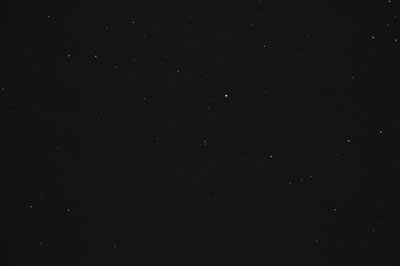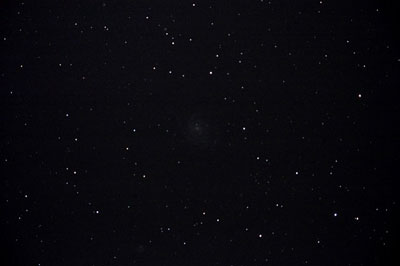Strictly speaking only the seven brightest stars of the much larger constellation of Ursa Major are called the Big Dipper. The stars of the Big Dipper were probably summarized to a constellation for the first time more than 15,000 years ago – at least there are cave paintings from the last ice age, in which one could see the constellation representing a bear. Still today, it is named Big Bear, which is the meaning of the Latin name Ursa Major. However, this interpretation of the drawings is not without controversy. Almost every nation has its own name for this striking group. Whether it depicts a Plow, a Wagon, a Casserole, a Dipper, a Bear, a funeral cortege or a court official with petitioners – the names of this group of stars are as varied as the cultures.
While the stars of a constellation usually don‘t have any physical relationship, most of the stars of the Big Dipper belong to the open cluster Collinder 285. The constellation is also very helpful for orientation in the sky – the rear box stars point to the North Star, and the swing of the handle leads across the spring sky over Arcturus in Bootes to Spica in Virgo.
Mizar and Alkor are listed in the star catalogs, among other names, as ζ and 80 Ursae Majoris and form the most famous optical double star. The central star of the Big Dipper‘s handle is separated by 12 arc minutes and should be seen as a double star with the naked eye. In the Persian army, this pair of stars was used for vision testing. The 78.2 light-years away Mizar is at 2.2m the brighter star. Alcor is 4.0m bright and 81.2 light-years away. The two stars are also known as the horse and its rider – a popular depiction of the Big Dipper is that of a wagon. At three light-years, the distance of the stars from each other is only slightly less than the distance between our Sun and its nearest neighboring star α Centauri.
Mizar itself is also a physical double star, whose 3.9m brighter companion was first observed in 1650. It stands 14.4 arcseconds close to Mizar, which corresponds to 336 AU or nine times the distance between the Sun and Pluto. The star probably needs 20,000 years for one orbit and was the first double star discovered in a telescope. In 1889 Mizar also became the first spectroscopic binary that has ever been discovered. Alcor is also a spectroscopic binary.
In 1857, the system belonged to the first stars that were photographed, and in 1925 for the first time the two components of a spectroscopic binary were separated at Mizar – there are two stars with 35 times the solar luminosity, which orbit each other every 20.5 days in a distance of only 18.6 miles (30 million kilometers). The observation was carried out with the 20 foot (6.1 meter) interferometer at Mount Wilson. Since then there were no further premiers with this famous star pair.
Why M 40 appears in Messier‘s catalog of nebulae will probably remain a mystery forever – even at 7x magnification you can separate this double star, which is also known as Winnecki 4. A 9.3m bright star is separated by 50 arc seconds from the 9.0m bright main star. The faint and inconspicuous star pair is 17 arc minutes northeast of another, 5.5m bright star. Johannes Hevelius described it in 1660 as “nebula over the back“ of the Great Bear – perhaps you can simulate this view with cheap opera glasses.

M 81 and M 82 are a pair of galaxies in the center of a small group of about a dozen galaxies similar to our own Local Group. At a distance of only 10 million light-years it is the second closest galaxy cluster, only the Sculptor Clusters is even closer to us. M 81 is now 7.2 million light-years away from Earth, while M 82 is separated by about 18 million light-years from us. 200 million years ago, the two galaxies passed each other, which caused increased star formation, especially in the more massive M82.
At 7.0m, M 81 is one with of the brightest spiral galaxies and is with 10 × 18 arc minutes almost half as large as the Moon. It appears smaller in binoculars, but you can see in a 10 × 50 the brighter core which is surrounded by the fainter halo of the spiral arms.
M 82 is located north of M 81. Even in 7 × 50 binoculars its irregular, cigar-like form is recognizable. At 8.4m, it is the brightest irregular galaxy. M 82 is traversed by great dust clouds; star formation is also still quite active in it. The 55,000 light-years large galaxy may be a spiral galaxy at which we are looking directly from the side.
The galaxy pair was first discovered in 1774 by Johann Elert Bode and is easy to find if you draw a line from γ to α Ursae Majoris and elongate it once. Under optimal conditions, they should be visible even with the naked eye – however, this is only for experienced observers.
Due to an error, the spiral galaxy NGC 5457 is listed twice in the Messier catalog – it was discovered as M 101 in March, 1781, and shortly after it was listed again as M 102. At 8.7m, the 28 × 28 arcmin large galaxy is the brightest member of a small group of galaxies. At least its seven minutes of arc large core can be seen in 10 × 50 binoculars with averted vision – not an easy target. Due to the large extent of the 190,000 light-years wide and 19 million light-years distant galaxy, it appears very faint. It is located northeast of a small chain of stars of fourth and fifth magnitude, 5.5° east of Mizar and Alcor.

M 108, although only 10.1m bright, can nevertheless be seen in 7 × 50 binoculars as a very thin line, 1° south-southwest of β Ursae Majoris. The 8 × 2 arcmin large spiral galaxy shows no central thickening even in photographs, although we look almost exactly from the side at the 23 million light-years distant star system. Probably dust clouds hide the center. Its luminosity is 1.7 times brighter than our Milky Way.
The 80 light-years distant open cluster Collinder 285 includes, among others, all the stars of the Big Dipper, with the exception of α and η. A total of fourteen of its stars can be well seen with the naked eye, including Gemma (α in the Northern Crown, Corona Borealis) and several stars in the Draco and the Leo Minor. The cluster was detected by comparing the common direction of the stars’ movement. The 18 × 30 light-years large group moves at 8.7 miles per second (14 km/s) into the direction of Sagittarius.
Collinder 285 is in the middle of the Ursa Major Stream, a group of more than 100 stars that move together through the galaxy. In addition to Sirius, the stream includes α in Ophiuchus, δ in Leo and β in Auriga. Our Sun is located (as well as Collinder 285) approximately in its center, but is not a member of it. Whether a relationship between the Ursa Major stream and Collinder 285 exists is not yet clear.
